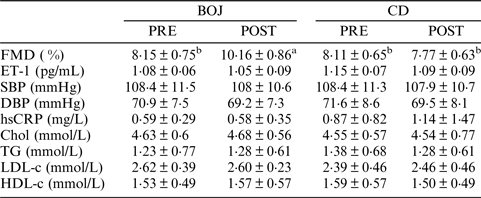Epidemiological studies have suggested an inverse association between the consumption of citrus fruit and the risk of cardiovascular diseases(Reference Cassidy, Bertoia and Chiuve1, Reference Landberg, Sun and Rimm2). However, little is known regarding the effects of daily consumption of blood orange juice on vascular function(Reference Buscemi, Rosafio and Arcoleo3). The aim of this study therefore was to investigate the effects of daily consumption of blood orange juice on vascular function and cardiovascular risk factors.
In this randomized controlled crossover trial, 15 overweight men and premenopausal women (aged 28·7 ± 1·7 y, BMI 28·3 ± 0·8 kg/m2) of European origin were asked to consume either blood orange juice or a low flavonoid control drink (400 ml/day) over a period of two weeks. Brachial artery flow-mediated dilation (FMD), blood pressure, anthropometric measures, lipid profile, high-sensitivity C reactive protein (hsCRP), endothelin 1 (ET-1) were evaluated before and after each intervention. FMD was conducted on specific days of the menstrual cycle to minimise the fluctuation in oestrogen levels, which were also monitored in serum samples. Shear rate as the stimulus for FMD was also calculated.
As shown in Table 1, FMD significantly increased following blood orange juice consumption, compared to the control drink (time by treatment interaction: P = 0·001) whereas shear rate and oestrogen levels were unchanged (data not shown), indicating improved endothelial function. The impact of the juice on FMD did not differ with gender (p = 0·922). Lipid profile, blood pressure, hsCRP, ET-1 were not affected by the intervention.
Table 1. Endothelial function, endothelin 1 (ET-1), blood pressure, lipid profile prior to and following 2-week consumption of blood orange juice (BOJ) and the control drink (CD).

All values are means ± SEMs. Means within the row without the same letter (a, b) are significantly different (P < 0.05). Differences in outcomes after each treatment were analysed by using a linear mixed model for crossover trials, with age, BMI, baseline values as covariates, subjects nested within treatment sequence as the random effect, and sequence, gender, dietary treatment, time, the interaction between treatment and time as fixed effects.
Present data indicate favourable effects of blood orange juice on endothelial function in healthy overweight subjects of European origin, which may in part be due to flavonoids present in orange juice. Although future studies are needed in larger cohorts to confirm the findings, our results are in accordance with epidemiological studies encouraging citrus consumption for the benefit of cardiovascular health.
This project was funded by the China Scholarship Council and the University of Leeds.



